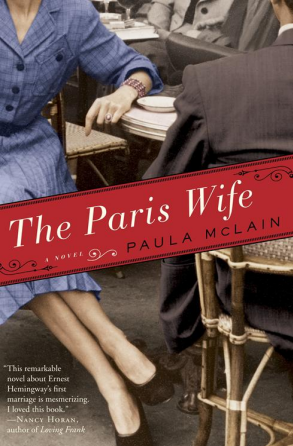By Leanna Pankratz (Contributor) – Email
Date Posted: September 27, 2011
Print Edition: September 21, 2011
 Sometimes, a great man’s story needs a woman’s touch.
Sometimes, a great man’s story needs a woman’s touch.
Literary connoisseurs around the world are familiar with Ernest Hemingway’s poignant memoir, A Moveable Feast. In trademark short, declarative sentences, he recalls his early years in Paris, when he and his first wife, Hadley, were “very poor, and very happy.” In many ways, Hemingway cherished this period of his life above all else. It was Paris in the 1920s. A time when a glittering society of artists congregated together, shared ideas, and drank like fish.
In The Paris Wife, Paula McLain rewrites A Moveable Feast from Hadley’s point of view, and captures the hopefulness and heartbreak experienced by the first Mrs. Hemingway. Readers will be quickly drawn into the story of twenty-eight year old Hadley Richardson – a Midwestern woman who had all but resigned herself to the life of a spinster, and most definitely had given up on excitement. In a whirlwind of events, she meets the young Ernest Hemingway, begins a passionate affair, marries him, and runs off to Paris. It is here that they live among the wild Jazz-Age expatriates, live out a romance, start a family, ride on hopefulness, and eventually fall apart in a mess of alcohol and adultery.
Because the novel is essentially a rewrite of Hemingway’s memoir, The Paris Wife offers readers the chance to vicariously socialize with the dazzling world of 1920s café society, and the American expatriates that inhabited it. McLain has clearly researched the time period extensively, and her portraits of artists such as Ezra Pound, Gertrude Stein, and the inimitable Scott and Zelda Fitzgerald, are like fine vignettes that capture the essence of people who would rather Charleston than walk. We view the antics and artistry through Hadley’s eyes, as she struggles to adjust her solid, Midwestern background to a world where champagne flows freely, parties last for days, and monogamy takes a backseat to the ménage à trois.
It would seem that amid such quirky company, the reserved and steadfast Hadley would become lost in the noise. Such an observation would be correct. In fact, upon first glance, readers may find McLain’s Hadley to be lacking in characterization – a sedate and stoic observer, almost frustrating in her passive support of her husband. Readers possessing any hint of the feminist spirit will cringe as she takes a backseat to Ernest’s artistic lifestyle, and quietly bears the burden of raising a son amid chaos. However, one may argue that this is exactly what McLain tries to convey in her Hadley. The Paris Wife is the story of a solid girl with solid values, and her love for a man who was larger than life.
Ernest Hemingway – the unmatched whirlwind of tenderness and testosterone – is humanized in this novel through Hadley’s soft, observant eyes. The Paris Wife differs from Feast in that regard. What we have is not a story penned by the man himself, but penned by the well-imagined hand of the woman who knew him better than anyone. We see him not merely as the great novelist, but as a lover, husband, and father – a man who revealed his greatest fears in his letters to his wife (excerpted by McLain in the novel), and watched in horror as his own life fell apart amid the parties and pandemonium that gradually drew him in.
Readers unfamiliar with the work or life of Ernest Hemingway will still be riveted by McLain’s take on one of America’s greatest literary love stories, and women especially will find ways to empathize with the insecurities and worries experienced by Hadley. The story is a page turner, with true life scenes played out in broad strokes. Readers can expect a sweeping love story, although, pleasantly, not once does McLain fall victim to cliché or dripping sentimentalism, as is the danger in novels such as this. She tells the tale in simple language, much reminiscent of Hemingway, and does not fail to pinpoint Hadley’s own flaws and faults.
While diehard fans of the man himself may find McLain’s retelling somewhat lackluster for its transformation of A Moveable Feast into a love story, they shouldn’t brush it off so hastily. What McLain offers is not a groundbreaking original piece, but rather a testament to a woman who was content to take a background role to her husband’s enormous personality – a woman whose story is sadly often overlooked. We’re presented with the story of a real woman who never swayed from who she was, who experienced passionate love and tremendous heartbreak, who placed family above all else, and who truly personified her husband’s mantra of “grace under pressure.”


